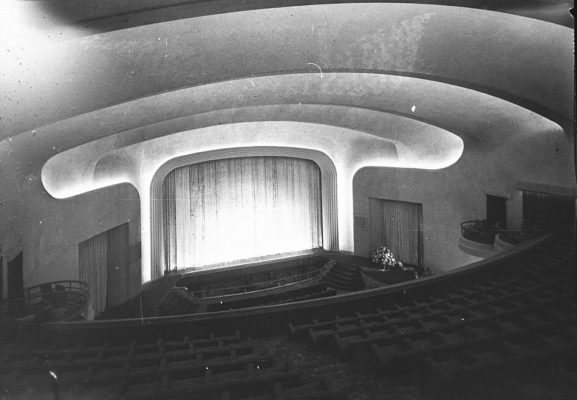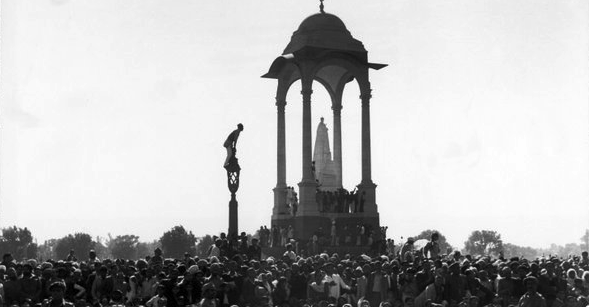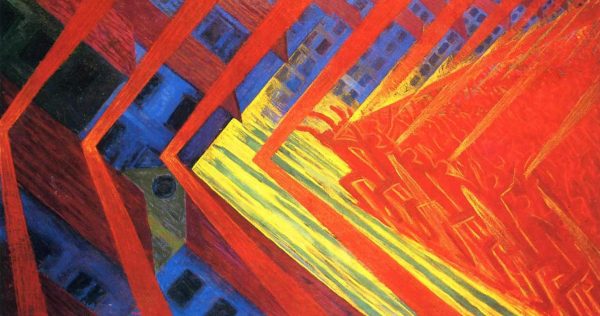Balanchine, the Wilis, and Collective Female Anger in Ballet
Growing up in ballet, I occasionally trained with a visiting instructor who had danced for George Balanchine in his glory days at New York City Ballet. She went by only her first name and titled her dance accordingly, perhaps in an attempt to mythologise herself in the same way she mythologised ‘Mr. B’ – when she spoke of him, her eyes took on a cultish glaze. I came to associate that mesmerised expression and a near-erotic love of dance with Balanchine dancers, many of whom never seem to have got over having been touched by The Master.
When she warned us that ageing as a dancer was an accelerated process, as though we were deteriorating in dog-years, I felt let in on a secret that connected me with a grand tradition of dancers. But she was also a cautionary tale: as I would imagine her preparing for her goddess-like descent on our class – brushing her wispy, waist-length white hair into a severe bun, wrapping her frame (which had no loose skin to indicate that she had ever gained weight or strayed from a balletic body) in tights and a chiffon skirt as though she were still a student – I felt unsafe from myself, as though I was quickly approaching a day when there would be nothing I could change about my life, either. Wanting could become an end unto itself.
Like many young dancers, I devoured former NYCB principal Gelsey Kirkland’s 1986 autobiography, Dancing on My Grave, which chronicles her rise from star student to principal dancer, her drug addiction, physical deterioration, and the pitfalls of being locked into Balanchine’s closed system of instruction. I read the book between classes in the crumbling building of my ballet school, breathing the characteristic scent of rosen, sweat, and Jet glue while the other girls stretched and tittered as the boys struggled to balance in their pointe shoes. For many, these interactions were their earliest flirtations, branded by the slightest betrayal of the strict balletic gender divide: women wear pointe shoes, extending their limbs to their most lengthened iteration; men lift them up. Kirkland’s suggestion that ‘ballet seemed infinitely preferable to the kind of romantic exchange valued by my peers’ resonated with me – how could the other students see their childish dalliances as worthwhile when we were learning the highest, most soulful art form? The girls who couldn’t see suffering as a noble pursuit, had bad feet, or gained the typical amount of weight during puberty (‘you can see more,’ Balanchine said of his preference for thinness) transitioned to modern dance or became civilians – the term some of us used to refer to non-dancers.
In a famous anecdote, now something of a cliché, often told about Balanchine, a doting mother consults him about whether or not her daughter is suited for dancing. Mr. B. responds: ‘La Danse, Madame, c’est une question morale.’ Dance as a moral consideration: while the abstraction is a bit maddening, it also seems to be inherent in those who choose to become dancers – those committed to the notion of an impossible beauty. A young woman well-suited to ballet considers suffering to be an integral element of craft, and the sadism or masochism that develops between a dancer and choreographer to be fruitful ground for expression, even at the expense of her own will. She is pleased to be an instrument, finding herself unable to bear a Mr. B’s attention, or the loss of it. She believes in generosity towards her audience, and that making gestures to represent experiences is preferable to speaking about them. At the end of the first act of Giselle, when the protagonist finds out that her prince is already engaged to another girl, she loses her sanity. Because it’s a ballet, and because she’s Giselle, her response to this betrayal is the impulse to dance while staggering around, grabbing at things that aren’t actually there. In most modern renditions, the ballerina’s hair is pinned in such a way that it will tumble down in tangled glory during this scene, so she can tug at it in a desperate, lionlike rage. A young girl suited for ballet might believe that in moments of terror and self-loss, she is supposed to be doing something with her hair.
I think of this young girl often: how the ideals of ballet might create hardship when she gets around to untangling her sexuality from dance – if she is able to. Lately, revisiting the memoirs and autobiographies of the dancers I admired as a child, I notice how these women have been warning each other all along. My tattered book is long lost, so I checked out a library copy of Kirkland’s autobiography before beginning this piece. In the margin of one page, as if to prepare for an interview with the writer, a previous borrower had written: ‘Ask why she’s so obsessed w/him’ (as though the book was not partially an attempt for Kirkland to figure this out for herself!). Some of the book’s most potent passages are when Kirkland recalls objectifying Balanchine, perhaps because they are the sole moments when believing in his magic does not come at her expense:
I developed the habit of mentally undressing him, without any attraction, simply fascinated to know if he possessed all the attributes of the male anatomy. In an effort to rationalise the idle speculation about his sexual inadequacy, I told myself that when God gave out genius, the other areas might be slighted, like a blessing withheld. I never considered the possibility that Balanchine’s genius and sexuality might be aberrations.
Balletic practice is fraught with dualities – man-woman, good-evil– without which, the notion of balletic beauty might crumble. NYCB founding partner Lincoln Kirstein wrote in his 1984 essay Beliefs of a Master that ballet dancers must strive to be otherworldly, and that ‘Balanchine’s ballets can be read as icons for the laity, should we grant dancers attributes of earthly angels’:
Modern and now postmodern dancers convince themselves and their annotators that minimal motion is as interesting to watch as to perform, at least to cult or coterie audiences in minimal spaces, clubs for companionship rather than frames for absolute skill. Minimal movement exploits a token idiom of natural motion: walk, turn, hop, run. Also, there is free-fall to the floor plus rolling and writhing. But angels don’t jerk or twitch, except for irony or accent: they seem to swim or fly… Angels are androgynous, lacking heavy bosoms and buttocks. Portraits of angels in mural or mosaic have slight physiognomic distinction one from another. There is a blessed lack of ‘personality’ in their stance against the skies. But this aerial or ethereal positioning grants them a special grace or magic in accepted service. Ballerinas are kin to those mythic Amazons who sliced off a breast to shoot arrows the more efficiently.
Trying to explain the appeal of Balanchine, or ballet, means resorting to such mythology and abstraction. Balanchine got away with a lot, largely by positioning women as muses: ‘Ballet is woman,’ he famously proclaimed. ‘God made men to sing the praises of women. They aren’t equal to men; they are better.’ Indeed, what makes Balanchine’s choreography so magical is the agency with which the female roles are danced. They are powerful, beautiful, larger-than-life muses, who men admire and serve. Yet, a decade after leaving the ballet world, proclamations like Balanchine’s strike me as being what a certain kind of man says that is, at best, hollow, at worst, manipulative. So often, the idealisation of women acts as a means of their diminishment.
The impeachable character of the genius male artist is among the most prevalent motifs in ballet mythology, alongside the notion that serving ballet (for a woman) means refuting real life – forgoing health, higher education, financial stability, a social life, love. Balanchine discouraged his dancers from marrying or having children, despite marrying four company dancers himself. In the classic dance film The Red Shoes, Lermontov, the company impresario, warns, ‘The dancer who relies upon the doubtful comforts of human love will never be a great dancer – never.’ Vicky, his star dancer, falls in love with another dancer, Julian, and keeps their relationship a secret from Lermontov. No matter: Lermontov learns of the partnership, fires Julian, and Vicky leaves the company with him. When Lermontov coerces Vicky back for a revival performance, both men contend for Vicky, and she is caught between her love for Julian and her need to dance. She chooses the latter, and serving Lermontov is conflated with serving ballet itself. For the ‘balletic male genius’, mistreatment of female dancers only adds to the mystique that surrounds him.
Predictably, the idealisation of the female dancer, or her male-genuis leader, has been reacted against strongly, as was the case with Peter Martins, who succeeded Balanchine at the NYCB after his death in 1983. A recent piece by Joan Arocella aptly points out the ‘spirit of antagonism’ in Martins’ early choreography, which eerily foreshadowed the laundry list of allegations of abuse and domestic violence Martins’ would later face: Calcium Light Night (1978), a severe, sarcastic duet in which a man and woman drag each other around the stage – ‘the opposite of Balanchine’s woman-worshipping duets’ – and Tanzspiel (1988), in which a woman approaches a man, but instead of mesmerising him, as in a Balanchine or classic romantic ballet, she grasps at him, pulls on him, and falls to the ground. He recoils, and eventually strangles her and dances around the stage with her lifeless body. ‘He hates ballerinas,’ an anonymous City Ballet dancer told Arocella in the late 1980s. ‘He hates beauty. He hates Balanchine.’
The highly publicised harassment and abuse allegations which led to Martins’ resignation in January 2018 were followed by a lawsuit filed in September 2018 by a former School of American Ballet (the school of NYCB) student, who alleges that a former principal dancer whom she had been dating, and several other male dancers in the company, exchanged nude photographs of herself and several other female dancers without their consent. The sacred fourth wall, separating dancers from their audience – and potentially obscuring troubling power dynamics within companies – has crumbled, and City Ballet (and, as an extension, Balanchine’s legacy) have come under scrutiny. The company has since done due damage control: dancers were lauded for a speech delivered by principal dancer Teresa Reichlen at the 2018 fall gala, in which she asserted that the dancers ‘will not put art before common decency or allow talent to sway our moral compass’, and drew connections between the dancerly pursuit of beauty and Balanchine’s work as the founding choreographer of the company. Suzanne Farrell, an original muse of Balanchine’s, returned to the company for the first time in 26 years in April 2019 to coach ballerinas in some of the roles that Balanchine created for her. Martins seldom invited alumni back to the company, even when rarely-performed Balanchine ballets were revived.
For many, like dance critic Alastair Macaulay, the lawsuit and scandals are indicators of how far the company has fallen from the stage behaviour demonstrated in Balanchine ballets, in which ‘women are honoured, exalted, shown to be compelling beings with needs and impulses that are not fully satisfied by romantic love’, while others have suggested that it was Balanchine’s questionable behaviour that set the precedent for the position that the NYCB finds itself in today. Balanchine chased youth, muses, and beauty: the balletic ideals built into language and culture.
His mythology was inscribed in the job description in the search for the new NYCB director, which writer James Steichen calls ‘a devotional plea, a yearning for a mythic saviour who likely does not exist.’ The listing charges the incoming director with ‘the training and development of dancers,’ and with ‘ensuring that the Balanchine and Robbins repertory and aesthetic are maintained and remain relevant for generations to come’, building upon said legacy with innovative new repertory, as well as participating in ‘marketing, fundraising, production, and education’. In other words, Steichen writes, ‘the new leader needs to have: 1) the musicality and choreographic genius of George Balanchine; 2) the dogged dedication and administrative aptitude of Lincoln Kirstein; and 3) the creative genius and protean adaptability of Jerome Robbins.’
Sensibly, NYCB has since divided up the roles, selecting former principal dancer Jonathan Stafford to lead the company and school as artistic director, while former principal dancer Wendy Whelen – one of the greatest artists in the company’s history, who has publicly criticised misogyny in the dance world – is the new associate artistic director, and the first woman to hold an artistic leadership role in the history of the company. Neither are choreographers, so Justin Peck, the company’s resident choreographer, will take the new title of artistic advisor. Whelan’s position in particular suggests that the dramatic shift many have hoped for may be underway: after retiring from NYCB, she turned her focus to contemporary dance (kinder than ballet to an ageing body, perhaps kinder to women), and, upon returning to the company, has expressed her intention to advance ‘more women choreographing’ and ‘more diversity on stage’, but also ‘bigger ideas, more open ideas, more daring ideas.’ So far, Whelan has kept her promise, commissioning new work from Lucinda Childs, the great postmodern choreographer whose works have mainly been performed in Europe. She has also initiated a dialogue with former dancers like Suzanne Farrell and Mimi Paul, whom Martins actively kept away from the NYCB studios during his tenure. All this will surely pave the way for more dynamic choreography, but the classics will still be performed.
In romantic ballets, mistreatment of women creates fertile ground for beauty and story. When the #MeToo movement reached City Ballet (quickly, insufferably dubbed #MeTutu), I thought of Giselle: the title character, a peasant girl, dies of a broken heart when she learns that her beloved, Albrecht (a prince concealed in the costume of the peasantry), has become engaged to another woman. She is relegated to the land of the Wilis: a group of ghostly girl-spirits who were betrayed by their lovers in life, and now haunt a graveyard, clad in eidolic white tulle. The Wilis are confined to the graveyard; they only encounter mortal men who happen to wander through their domain by night. They are a delicious, dynamic embodiment of collective female anger, indiscriminately seeking revenge on any man who comes their way by forcing him to dance until he dies of exhaustion. Giselle begs the Wilis to spare the prince who misled her, but they insist that he is as guilty as any man, and must die.
There are several different interpretations of the Wilis’ backstory, though most agree that they are women who died before their wedding day or were left at the altar, and could not find peace in their graves, instead choosing to seek revenge on all men. From that point, readings dissent: some choreographers and critics depict the Wilis as sexually frustrated, or suggest that they find sexual fulfilment in their murders. The group’s leader, a formidable Wili named Myrtha, either continues to condemn the women to their sexual frustration, or provides them release and satisfaction with each dead man. Romanticism is often described as a rejection of popular morality in the pursuit of individual desire. When we interpret the Wilis this way, it’s noticeable that Giselle does the opposite, denying herself a sexually fulfilling experience in an attempt to save Albrecht.
Romantic ballets like Giselle have a history of being used as political tools. The noble Albrecht’s betrayal of the poor, peasant Giselle could be seen as a symbol of the harm done by the bourgeoisie, the very audience to which it was presented. In his book A Queer History of the Ballet, Peter Stoneley writes that the tradition of ballet blanc was likely seen as an erotic spectacle: when Giselle premiered at the Paris opera in 1841, the corps de ballet members who played the Wilis were expected to participate in a system of prostitution légère, endorsed by the opera, in which the women were connected with wealthy ballet patrons who made donations to the ballet in exchange for sexual favours or special attention from the dancers. The Palais Garnier even featured a ‘foyer de la dance’: an offstage arena designed to encourage encounters between high-paying patrons and the young dancers, which wives and male dancers were not allowed to enter. In the 1800s, these practices carried the fatal threat of syphilis, and as Felicia McCarren writes in Dance Pathologies, the danger translated to the stage: the Wilis represented ‘many of the nightmares about female sexuality made evident in contemporary attitudes towards prostitution.’
The pathologisation of Giselle’s sexual ‘deviance’ and her ‘madness’ provided the basis for Swedish choreographer Mats Ek’s poststructuralist reworking of Giselle, which premiered in 1982. In this rendition, Giselle propositions Albrecht, indicating to him that although she is not fertile, she still has sexual desire. She desires Albrecht, whose requited desire stems from his exchanges with Giselle, rather than from a mythology surrounding her figure. Instead of dying of a broken heart, Giselle is banished to a mental asylum. Thus, the death of her body at the beginning of the first act can be read as synonymous with the loss of her sanity. The second act takes place in an asylum, where the Wilis are recontextualised as Giselle’s fellow patients: they will never be mothers, will only ever be frustrated. With nothing to control their desire, they are ruled by sexual impulsivity. Mythra is a nurse reminiscent of Racthed in One Flew Over the Cuckoo’s Nest. The surreal sets by Marie-Louise De Geer-Bergenstrahle feature dismembered pieces of the female body scattered across the asylum walls. In a manoeuvre akin to the fainting husband in Charlotte Perkins Gilman’s The Yellow Wallpaper, Albrecht follows Giselle in succumbing to madness.
Ek’s isn’t an emancipatory vision, but it does seem to hold culture, and by extension balletic culture, more accountable for what it does to women. When asked if he considered the production to be de-romanticised, Ek responded, ‘That depends on what you mean by “romantic”. If you mean “pretty and sweet”, well, no, they’re not part of it. But if you mean what “romantic” signified from the beginning – something wild and illogical, something to which you can’t respond with your reason – then, absolutely, this is a romantic ballet.’ Indeed, Théophile Gautier, who wrote the scenario for Giselle, was celebrated as an abandonné – one who yields or abandons oneself to a great artistic vision.
The remaining question, of course, is whether dancers, and the characters they portray, abandon themselves to or for something. In the traditional romantic version of Giselle, Myrtha, queen of the Wilis, coldly ignores Giselle’s pleas for the prince’s life. Male energy can run dry, but the wrath of women is infinite, unyielding. Albrecht deserves to die, Myrtha insists, and Giselle should relish in his death with the rest of the scorned she-ghosts. But because it’s a ballet, Giselle’s merciful love rescues the prince, and she gets to rest peacefully in her grave. I’ve always wondered if a small but significant part of Giselle wanted to join the Wilis in their ravenous animus. The conditions of her choice feel contemporary: weaponise your collective female anger, or lie with your mercy in a coffin.




